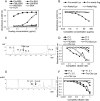Glucoselysine is derived from fructose and accumulates in the eye lens of diabetic rats
- PMID: 31594865
- PMCID: PMC6873178
- DOI: 10.1074/jbc.RA119.010744
Glucoselysine is derived from fructose and accumulates in the eye lens of diabetic rats
Abstract
Prolonged hyperglycemia generates advanced glycation end-products (AGEs), which are believed to be involved in the pathogenesis of diabetic complications. In the present study, we developed a polyclonal antibody against fructose-modified proteins (Fru-P antibody) and identified its epitope as glucoselysine (GL) by NMR and LC-electrospray ionization (ESI)- quadrupole TOF (QTOF) analyses and evaluated its potential role in diabetes sequelae. Although the molecular weight of GL was identical to that of fructoselysine (FL), GL was distinguishable from FL because GL was resistant to acid hydrolysis, which converted all of the FLs to furosine. We also detected GL in vitro when reduced BSA was incubated with fructose for 1 day. However, when we incubated reduced BSA with glucose, galactose, or mannose for 14 days, we did not detect GL, suggesting that GL is dominantly generated from fructose. LC-ESI-MS/MS experiments with synthesized [13C6]GL indicated that the GL levels in the rat eye lens time-dependently increase after streptozotocin-induced diabetes. We observed a 31.3-fold increase in GL 8 weeks after the induction compared with nondiabetic rats, and Nϵ-(carboxymethyl)lysine and furosine increased by 1.7- and 21.5-fold, respectively, under the same condition. In contrast, sorbitol in the lens levelled off at 2 weeks after diabetes induction. We conclude that GL may be a useful biological marker to monitor and elucidate the mechanism of protein degeneration during progression of diabetes.
Keywords: AGEs; diabetes; glucoselysine; glycation; lens; mass spectrometry (MS); nuclear magnetic resonance (NMR); polyclonal antibody; polyol pathway; post-translational modification (PTM).
© 2019 Ohno et al.
Conflict of interest statement
The authors declare that they have no conflicts of interest with the contents of this article.
Figures







Similar articles
-
Glucoselysine, a unique advanced glycation end-product of the polyol pathway and its association with vascular complications in type 2 diabetes.J Biol Chem. 2024 Jul;300(7):107479. doi: 10.1016/j.jbc.2024.107479. Epub 2024 Jun 13. J Biol Chem. 2024. PMID: 38879006 Free PMC article.
-
Specific detections of the early process of the glycation reaction by fructose and glucose in diabetic rat lens.FEBS Lett. 1998 Dec 11;441(1):116-20. doi: 10.1016/s0014-5793(98)01529-4. FEBS Lett. 1998. PMID: 9877177
-
Insights from the fructose-derived product glucoselysine: Revisiting the polyol pathway in diabetic complications.J Diabetes Investig. 2025 Apr;16(4):569-577. doi: 10.1111/jdi.70000. Epub 2025 Feb 1. J Diabetes Investig. 2025. PMID: 39891559 Free PMC article. Review.
-
Immunochemical detection of glycated beta- and gamma-crystallins in lens and their circulating autoantibodies (IgG) in streptozocin induced diabetic rat.Mol Vis. 2006 Sep 13;12:1077-85. Mol Vis. 2006. PMID: 17093392
-
Accumulation of fructosyl-lysine and advanced glycation end products in the kidney, retina and peripheral nerve of streptozotocin-induced diabetic rats.Biochem Soc Trans. 2003 Dec;31(Pt 6):1423-5. doi: 10.1042/bst0311423. Biochem Soc Trans. 2003. PMID: 14641079 Review.
Cited by
-
Slot Blot- and Electrospray Ionization-Mass Spectrometry/Matrix-Assisted Laser Desorption/Ionization-Mass Spectrometry-Based Novel Analysis Methods for the Identification and Quantification of Advanced Glycation End-Products in the Urine.Int J Mol Sci. 2024 Sep 5;25(17):9632. doi: 10.3390/ijms25179632. Int J Mol Sci. 2024. PMID: 39273579 Free PMC article.
-
Rapid pretreatment for multi-sample analysis of advanced glycation end products and their role in nephropathy.J Clin Biochem Nutr. 2022 May;70(3):256-261. doi: 10.3164/jcbn.21-175. Epub 2022 Mar 31. J Clin Biochem Nutr. 2022. PMID: 35692677 Free PMC article.
-
Glucoselysine, a unique advanced glycation end-product of the polyol pathway and its association with vascular complications in type 2 diabetes.J Biol Chem. 2024 Jul;300(7):107479. doi: 10.1016/j.jbc.2024.107479. Epub 2024 Jun 13. J Biol Chem. 2024. PMID: 38879006 Free PMC article.
-
Non-invasive evaluation of advanced glycation end products in hair as early markers of diabetes and aging.Sci Rep. 2025 Aug 18;15(1):30232. doi: 10.1038/s41598-025-15481-z. Sci Rep. 2025. PMID: 40825821 Free PMC article.
-
Analysis of Crude, Diverse, and Multiple Advanced Glycation End-Product Patterns May Be Important and Beneficial.Metabolites. 2023 Dec 19;14(1):3. doi: 10.3390/metabo14010003. Metabolites. 2023. PMID: 38276293 Free PMC article.
References
-
- Schleicher E. D., Gerbitz K. D., Dolhofer R., Reindl E., Wieland O. H., Edelmann E., Haslbeck M., Kemmler W., Walter H., and Mehnert H. (1984) Clinical utility of nonenzymatically glycosylated blood proteins as an index of glucose control. Diabetes Care 7, 548–556 10.2337/diacare.7.6.548 - DOI - PubMed
MeSH terms
Substances
LinkOut - more resources
Full Text Sources
Other Literature Sources
Medical

